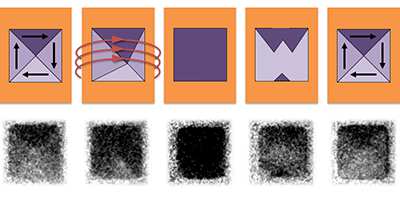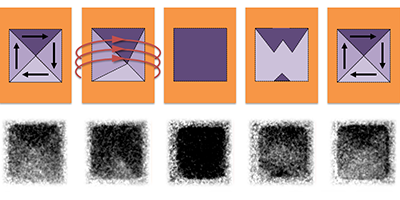Unraveling the Vortex
Modern computer memories store data by writing magnetization patterns into magnetizable materials at ever-increasing speeds and densities. An x-ray imaging technique has now been used to image the magnetic dynamics inside a structure that holds promise for future data storage devices: a micrometer-sized square of magnetic permalloy that contains, at its center, a magnetic vortex—a curling arrangement of the magnetic domains. A single vortex could store two bits of information in a single unit through its four possible magnetization states (up, down, clockwise, anticlockwise). Understanding how fast such vortices can be formed and destroyed requires experiments able to probe their natural temporal and spatial scales.
Magnetic domain patterns are typically imaged using an x-ray microscope (mapping the orientation of the magnetic domains via their polarization-dependent x-ray absorption) at an x-ray synchrotron beamline. To image the dynamic reorganization of the vortex, Philipp Wessels from The Hamburg Centre for Ultrafast Imaging, Germany, and colleagues synchronized the short synchrotron x-ray flashes with a high applied magnetic-field pulse, realizing a pump-probe x-ray stroboscope capable of capturing magnetization dynamics with 200-picosecond resolution.
Unlike previous experiments that studied the vortex response to slight perturbations, the magnetic field used by Wessels et al. was high enough to destroy the initial vortex configuration. The recorded images show that as the field is applied the vortex starts to unravel, spiraling out at a speed exceeding 1 kilometer per second, until the sample is homogeneously magnetized (all domains aligned). This process takes less than 400 picoseconds. The permalloy then remains homogenously magnetized until the magnetic field is removed, after which it slowly recovers its original magnetization configuration.
This research is published in Physical Review B.
–Katherine Wright





